

Reference: Judicial independence
THE prestige associated with the European Patent Office (EPO) is long gone. The conditions for workers aren't attractive, the quality of the work is not high, and the experienced/talented examiners are leaving/retiring (or have already left/retired). Some people and some companies aren't aware of it yet; they're stuck in the past -- way back when the EPO was best bar none. Talicia's pursuit of a European Patent has just been noted in this new press release, but have they paid attention to the high rate of rejection in European courts (judges in effect overturning examiners' decisions)?
The European Patent Office’s (EPO) Technical Board of Appeal has referred questions relating to computer-implemented inventions to the Enlarged Board of Appeal (EBA).
This is the second time that questions relating to the patentability of software have been considered by the EBA, according to law firm Venner Shipley.
“Indeed, it could be the first case that the EBA actively decides on a point of fundamental importance: although the EBA considered a referral in G 3/08 (Programs for computers), it declined to hand down a decision, ruling that the referral was inadmissible,” said a release from Venner Shipley.
The law firm drafted and prosecuted the patent application, which covers an invention for modelling pedestrian movement which can be used to help design or modify venues such as a railway station or stadium.
EPO Technical Board of Appeal 3.5.07 has, in case T 0489/14 (Pedestrian simulation/CONNOR), referred questions to the Enlarged Board of appeal concerning what is to be considered technical in the fields of design and simulation. The cases of Designing optical systems/Philips and Circuit Simulation I/Infineon have long been cited as precedent that the design or simulation of a technical system is itself technical and eligible for patent protection. However, some more recent cases have put limits on that proposition, suggesting that the technical system must be defined with sufficient specificity and that the purpose of the simulation might also be relevant.
[...]
The Board accepted that the simulation in Connor was analogous to that in Infineon and so ought to be patentable under the reasoning of Infineon. However, the Board "is not fully convinced" by the reasoning of Infineon and the questions referred could overturn or reduce the precedent effect of Infineon.
The first question referred to the Enlarged Board seeks to test Board 3.5.07's view that "a technical effect requires a direct link with physical reality" and that it is not enough for technical character that a technical (i.e. physical) system is simulated. However, a negative answer to this question would imply that no modelling or simulation inventions were patentable.
The second question, to be addressed if the Enlarged Board considers that something more than merely simulating a technical system is required, asks what more is required. The question implies that it is at least necessary that the simulation be based on technical principles underlying the systems. This would perhaps exclude some recent cases relating economic modelling of wind farms and mobile phone networks.
The final question addresses the common fall-back position in simulation and design cases: to include a step of manufacturing or controlling something physical. This has long been thought to be a safe port of last resort, especially since the UK case of Halliburton v Comptroller-General of Patents [2011] EWHC 2508 (Pat). If the Enlarged Board were to decide that inclusion of such features is not sufficient to save a claim to a design or simulation method, a great many cases would be affected.